Sacral Dermatomes: Spinal Nerves and Their Locations Explained
What are sacral dermatomes. How many dermatomes are there and where can they be found in the body? Explore the spinal nerves associated with each dermatome.
Spinal Nerves and Their Role in Dermatomes
Spinal nerves are part of the peripheral nervous system (PNS) and connect the central nervous system (CNS), comprised of the brain and spinal cord, to the rest of the body. There are 31 pairs of spinal nerves that form nerve roots branching from the spinal cord. These spinal nerves are categorized into five main groups based on the region of the spine they are associated with:
- Cervical nerves: 8 pairs numbered C1 through C8, originating from the neck
- Thoracic nerves: 12 pairs numbered T1 through T12, originating from the torso
- Lumbar nerves: 5 pairs numbered L1 through L5, originating from the lower back
- Sacral nerves: 5 pairs, originating from the sacrum in the pelvis
- Coccygeal nerves: 1 pair, originating from the coccyx or tailbone
What are Dermatomes?
A dermatome is an area of skin supplied by a single spinal nerve. The body has 30 dermatomes, one less than the number of spinal nerves, as the C1 nerve typically lacks a sensory root. Dermatomes are distributed in a segmented pattern throughout the body, with some overlap between neighboring dermatomes possible.
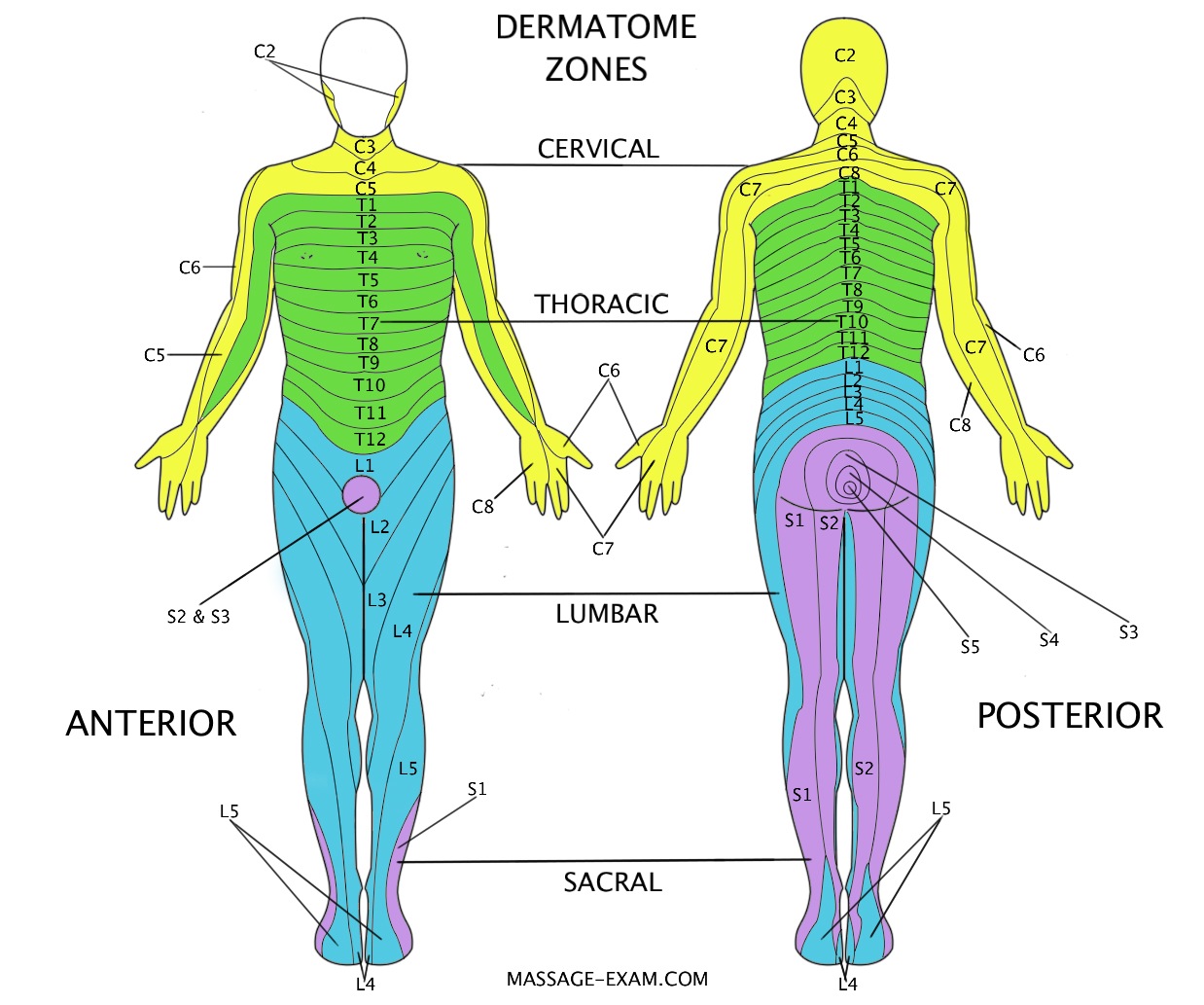
Dermatome Patterns and Locations
The dermatome pattern differs between the torso/core and the limbs. On the torso, dermatomes are distributed horizontally, appearing as stacked discs when viewed on a body map. In the limbs, dermatomes run vertically along the long axis of the limb.
Dermatomes are numbered based on the corresponding spinal nerve. Let’s look at the specific areas of the body associated with each dermatome:
Cervical Dermatomes
- C2: Lower jaw, back of the head
- C3: Upper neck, back of the head
- C4: Lower neck, upper shoulders
- C5: Collarbone area, upper shoulders
- C6: Shoulders, outside of arm, thumb
- C7: Upper back, back of arm, pointer and middle finger
- C8: Upper back, inside of arm, ring and little finger
Thoracic Dermatomes
- T1: Upper chest and back, armpit, front of arm
- T2-T6: Upper and mid-chest and back
- T7-T8: Mid-chest and back
- T9-T10: Upper abdomen and mid-back
- T11-T12: Lower abdomen and mid-back
Lumbar Dermatomes
- L1: Lower back, hips, groin
- L2-L3: Lower back, front and inside of thigh
- L4: Lower back, front of thigh and calf, knee, inside of ankle
- L5: Lower back, front and outside of calf, top and bottom of foot, first four toes
Sacral Dermatomes
- S1: Lower back, back of thigh, back and inside of calf, last toe
- S2-S3: Buttocks, genitals, back of thigh and calf
- S4-S5: Buttocks
Coccygeal Dermatome
- Coccygeal: Buttocks, area of tailbone
Why are Dermatomes Important?
Dermatomes are important because they can help healthcare professionals assess and diagnose various conditions. Symptoms that occur along a specific dermatome may indicate a problem with a corresponding nerve root in the spine, such as in cases of radiculopathy (nerve root compression or pinching). Understanding dermatome patterns can also aid in the diagnosis and treatment of other conditions affecting the nervous system.
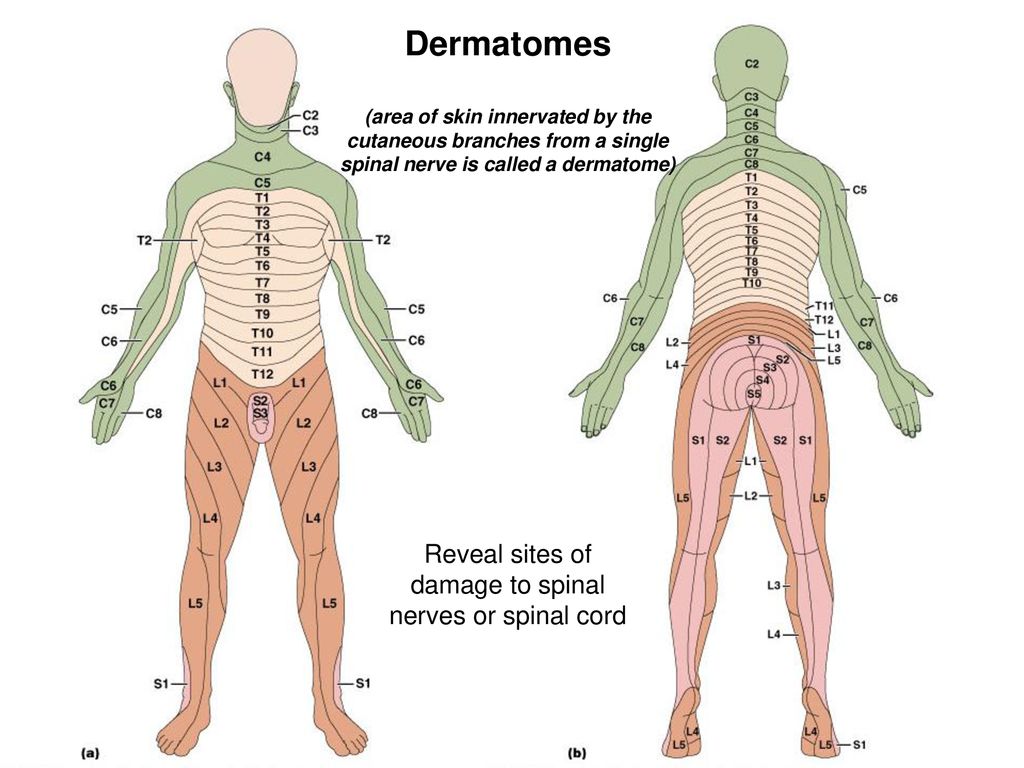
Key Takeaways
- There are 31 pairs of spinal nerves that form nerve roots branching from the spinal cord, categorized into five main groups based on spinal regions.
- A dermatome is an area of skin supplied by a single spinal nerve, and the body has 30 dermatomes.
- Dermatomes have a segmented distribution across the body, with a horizontal pattern on the torso and a vertical pattern in the limbs.
- Dermatomes are numbered based on the corresponding spinal nerve, and each has a specific area of the body it is associated with.
- Understanding dermatomes is important for assessing and diagnosing various neurological conditions, such as radiculopathies.
Dermatomes Diagram: Spinal Nerves and Locations
A dermatome is an area of skin supplied by a single spinal nerve. There are 31 pairs of spinal nerves, forming nerve roots that branch from your spinal cord.
Your spinal nerves help to relay sensory, motor, and autonomic information between the rest of your body and your central nervous system (CNS).
So why are dermatomes important? How many are there? And where can they be found? Continue reading as we answer these questions and more.
Each of your dermatomes is supplied by a single spinal nerve. Let’s take a closer look at both of these components of the body.
Your spinal nerves
Spinal nerves are part of your peripheral nervous system (PNS). Your PNS works to connect the rest of your body with your CNS, which is made up of your brain and spinal cord.
You have 31 pairs of spinal nerves. They form nerve roots that branch from your spinal cord. Spinal nerves are named and grouped by the region of the spine that they’re associated with.
The five groups of spinal nerves are:
- Cervical nerves. There are eight pairs of these cervical nerves, numbered C1 through C8. They originate from your neck.
- Thoracic nerves. You have 12 pairs of thoracic nerves that are numbered T1 through T12. They originate in the part of your spine that makes up your torso.
- Lumbar nerves. There are five pairs of lumbar spinal nerves, designated L1 through L5. They come from the part of your spine that makes up your lower back.
- Sacral nerves. Like the lumbar spinal nerves, you also have five pairs of sacral spinal nerves. They’re associated with your sacrum, which is one of the bones found in your pelvis.
- Coccygeal nerves. You only have a single pair of coccygeal spinal nerves. This pair of nerves originates from the area of your coccyx, or tailbone.
Your dermatomes
Each of your dermatomes is associated with a single spinal nerve.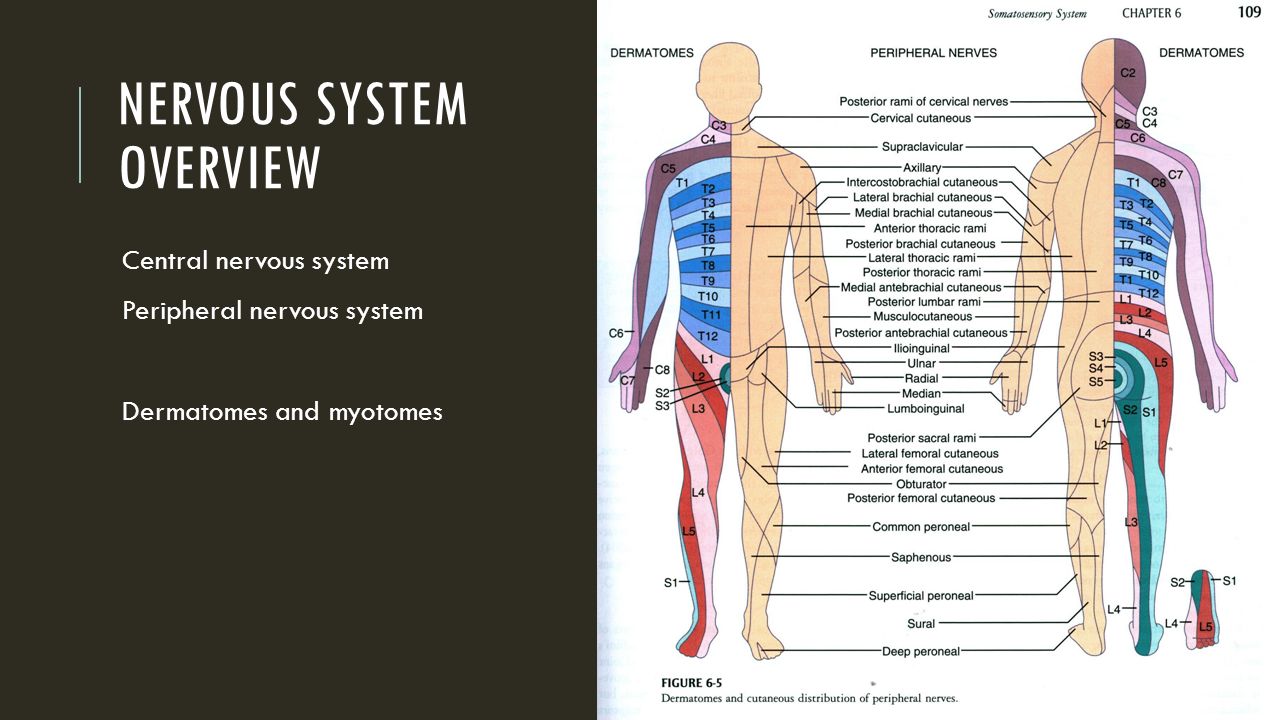 These nerves transmit sensations, such as pain, from a specific area of your skin to your CNS.
These nerves transmit sensations, such as pain, from a specific area of your skin to your CNS.
Your body has 30 dermatomes. You may have noticed that this is one less than the number of spinal nerves. This is because the C1 spinal nerve typically doesn’t have a sensory root. As a result, dermatomes begin with spinal nerve C2.
Dermatomes have a segmented distribution throughout your body. The exact dermatome pattern can actually vary from person to person. Some overlap between neighboring dermatomes may also occur.
Because your spinal nerves exit your spine laterally, dermatomes associated with your torso and core are distributed horizontally. When viewed on a body map, they appear very much like stacked discs.
The dermatome pattern in the limbs is slightly different. This is due to the shape of the limbs as compared with the rest of the body. In general, dermatomes associated with your limbs run vertically along the long axis of the limbs, such as down your leg.
Your dermatomes are numbered based on which spinal nerve they correspond to. Below, we’ll outline each dermatome and the area of the body that it’s associated with.
Remember that the exact area that a dermatome may cover can vary by individual. Some overlap is also possible. As such, consider the outline below to be a general guide.
Cervical spinal nerves
- C2: lower jaw, back of the head
- C3: upper neck, back of the head
- C4: lower neck, upper shoulders
- C5: area of the collarbones, upper shoulders
- C6: shoulders, outside of arm, thumb
- C7: upper back, back of arm, pointer and middle finger
- C8: upper back, inside of arm, ring and little finger
Thoracic spinal nerves
- T1: upper chest and back, armpit, front of arm
- T2: upper chest and back
- T3: upper chest and back
- T4: upper chest (area of nipples) and back
- T5: mid-chest and back
- T6: mid-chest and back
- T7: mid-chest and back
- T8: upper abdomen and mid-back
- T9: upper abdomen and mid-back
- T10: abdomen (area of belly button) and mid-back
- T11: abdomen and mid-back
- T12: lower abdomen and mid-back
Lumbar spinal nerves
- L1: lower back, hips, groin
- L2: lower back, front and inside of thigh
- L3: lower back, front and inside of thigh
- L4: lower back, front of thigh and calf, area of knee, inside of ankle
- L5: lower back, front and outside of calf, top and bottom of foot, first four toes
Sacral spinal nerves
- S1: lower back, back of thigh, back and inside of calf, last toe
- S2: buttocks, genitals, back of thigh and calf
- S3: buttocks, genitals
- S4: buttocks
- S5: buttocks
Coccygeal spinal nerves
buttocks, area of tailbone
Dermatomes are important because they can help to assess and diagnose a variety of conditions.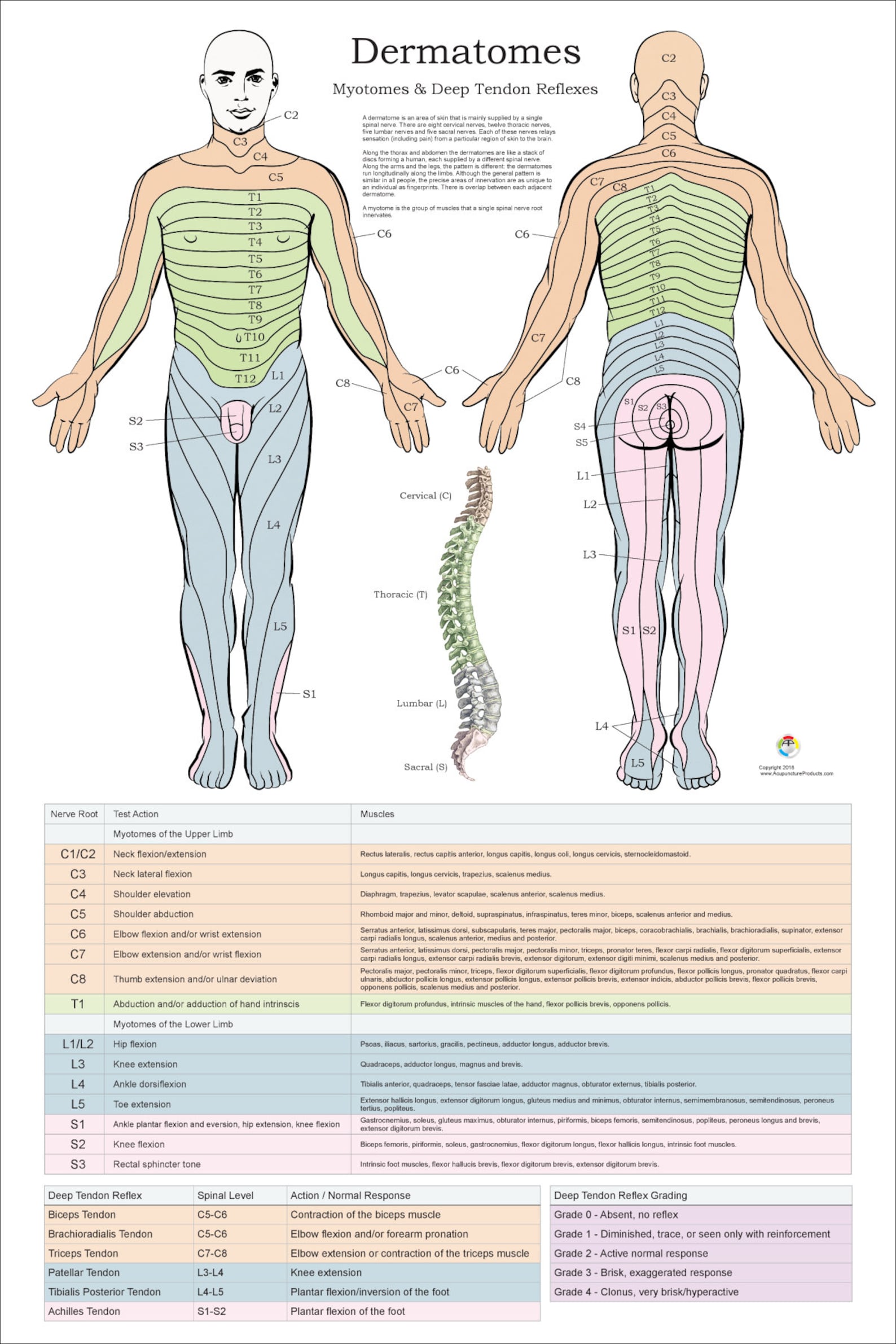 For instance, symptoms that occur along a specific dermatome may indicate a problem with a specific nerve root in the spine.
For instance, symptoms that occur along a specific dermatome may indicate a problem with a specific nerve root in the spine.
Examples of this include:
- Radiculopathies. This refers to conditions in which a nerve root in the spine is compressed or pinched. Symptoms can include pain, weakness, and tingling sensations. Pain from radiculopathies can follow one or more dermatomes. One form of a radiculopathy is sciatica.
- Shingles. Shingles is a reactivation of the varicella zoster (chickenpox) virus that lies dormant in the nerve roots of your body. Symptoms of shingles, such as pain and a rash, occur along dermatomes associated with the affected nerve root.
Dermatomes are areas of skin that are connected to a single spinal nerve. You have 31 spinal nerves and 30 dermatomes. The exact area that each dermatome covers can be different from person to person.
Spinal nerves help to relay information from other parts of your body to your central nervous system. As such, each dermatome transmits sensory details from a particular area of skin back to your brain.
As such, each dermatome transmits sensory details from a particular area of skin back to your brain.
Dermatomes can be helpful in evaluating and diagnosing conditions affecting the spine or nerve roots. Experiencing symptoms along a specific dermatome can help inform doctors about which area of the spine may be affected.
Dermatomes Diagram: Spinal Nerves and Locations
A dermatome is an area of skin supplied by a single spinal nerve. There are 31 pairs of spinal nerves, forming nerve roots that branch from your spinal cord.
Your spinal nerves help to relay sensory, motor, and autonomic information between the rest of your body and your central nervous system (CNS).
So why are dermatomes important? How many are there? And where can they be found? Continue reading as we answer these questions and more.
Each of your dermatomes is supplied by a single spinal nerve. Let’s take a closer look at both of these components of the body.
Your spinal nerves
Spinal nerves are part of your peripheral nervous system (PNS).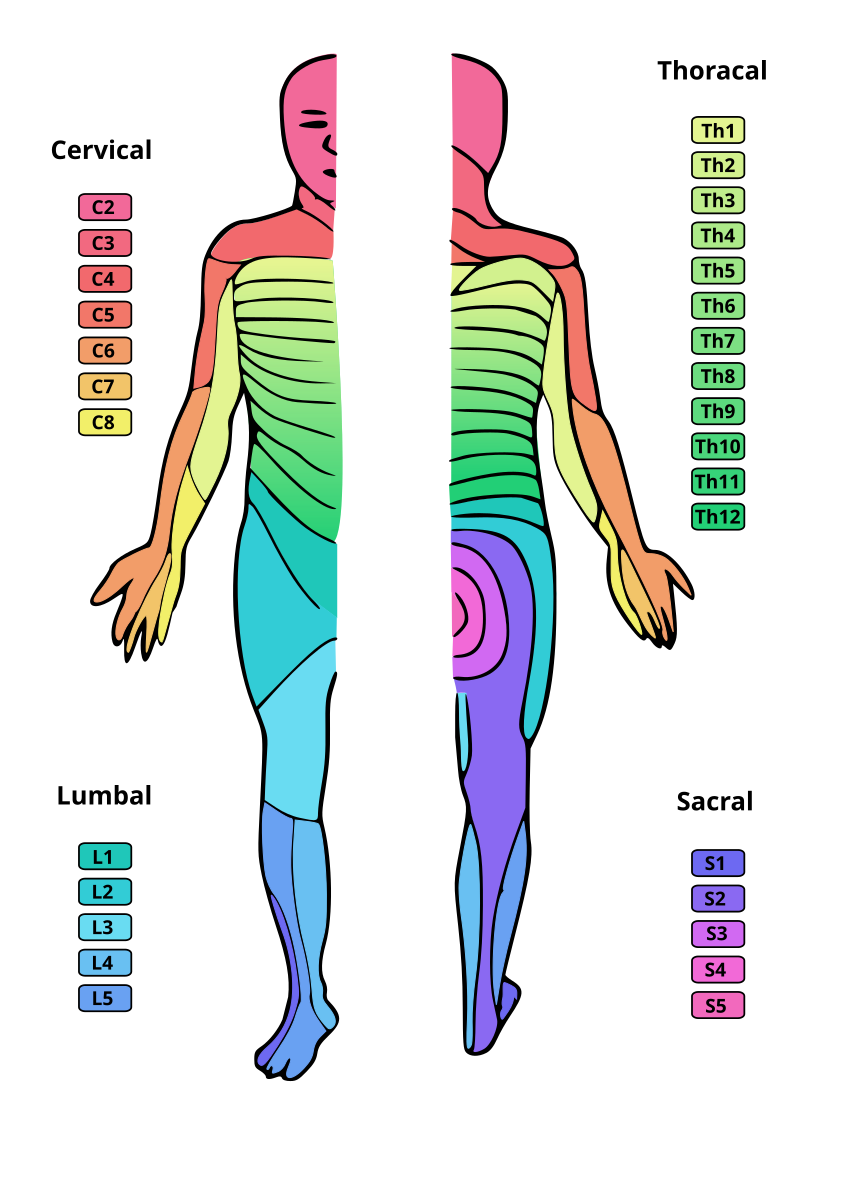 Your PNS works to connect the rest of your body with your CNS, which is made up of your brain and spinal cord.
Your PNS works to connect the rest of your body with your CNS, which is made up of your brain and spinal cord.
You have 31 pairs of spinal nerves. They form nerve roots that branch from your spinal cord. Spinal nerves are named and grouped by the region of the spine that they’re associated with.
The five groups of spinal nerves are:
- Cervical nerves. There are eight pairs of these cervical nerves, numbered C1 through C8. They originate from your neck.
- Thoracic nerves. You have 12 pairs of thoracic nerves that are numbered T1 through T12. They originate in the part of your spine that makes up your torso.
- Lumbar nerves. There are five pairs of lumbar spinal nerves, designated L1 through L5. They come from the part of your spine that makes up your lower back.
- Sacral nerves. Like the lumbar spinal nerves, you also have five pairs of sacral spinal nerves. They’re associated with your sacrum, which is one of the bones found in your pelvis.

- Coccygeal nerves. You only have a single pair of coccygeal spinal nerves. This pair of nerves originates from the area of your coccyx, or tailbone.
Your dermatomes
Each of your dermatomes is associated with a single spinal nerve. These nerves transmit sensations, such as pain, from a specific area of your skin to your CNS.
Your body has 30 dermatomes. You may have noticed that this is one less than the number of spinal nerves. This is because the C1 spinal nerve typically doesn’t have a sensory root. As a result, dermatomes begin with spinal nerve C2.
Dermatomes have a segmented distribution throughout your body. The exact dermatome pattern can actually vary from person to person. Some overlap between neighboring dermatomes may also occur.
Because your spinal nerves exit your spine laterally, dermatomes associated with your torso and core are distributed horizontally. When viewed on a body map, they appear very much like stacked discs.
The dermatome pattern in the limbs is slightly different. This is due to the shape of the limbs as compared with the rest of the body. In general, dermatomes associated with your limbs run vertically along the long axis of the limbs, such as down your leg.
Your dermatomes are numbered based on which spinal nerve they correspond to. Below, we’ll outline each dermatome and the area of the body that it’s associated with.
Remember that the exact area that a dermatome may cover can vary by individual. Some overlap is also possible. As such, consider the outline below to be a general guide.
Cervical spinal nerves
- C2: lower jaw, back of the head
- C3: upper neck, back of the head
- C4: lower neck, upper shoulders
- C5: area of the collarbones, upper shoulders
- C6: shoulders, outside of arm, thumb
- C7: upper back, back of arm, pointer and middle finger
- C8: upper back, inside of arm, ring and little finger
Thoracic spinal nerves
- T1: upper chest and back, armpit, front of arm
- T2: upper chest and back
- T3: upper chest and back
- T4: upper chest (area of nipples) and back
- T5: mid-chest and back
- T6: mid-chest and back
- T7: mid-chest and back
- T8: upper abdomen and mid-back
- T9: upper abdomen and mid-back
- T10: abdomen (area of belly button) and mid-back
- T11: abdomen and mid-back
- T12: lower abdomen and mid-back
Lumbar spinal nerves
- L1: lower back, hips, groin
- L2: lower back, front and inside of thigh
- L3: lower back, front and inside of thigh
- L4: lower back, front of thigh and calf, area of knee, inside of ankle
- L5: lower back, front and outside of calf, top and bottom of foot, first four toes
Sacral spinal nerves
- S1: lower back, back of thigh, back and inside of calf, last toe
- S2: buttocks, genitals, back of thigh and calf
- S3: buttocks, genitals
- S4: buttocks
- S5: buttocks
Coccygeal spinal nerves
buttocks, area of tailbone
Dermatomes are important because they can help to assess and diagnose a variety of conditions.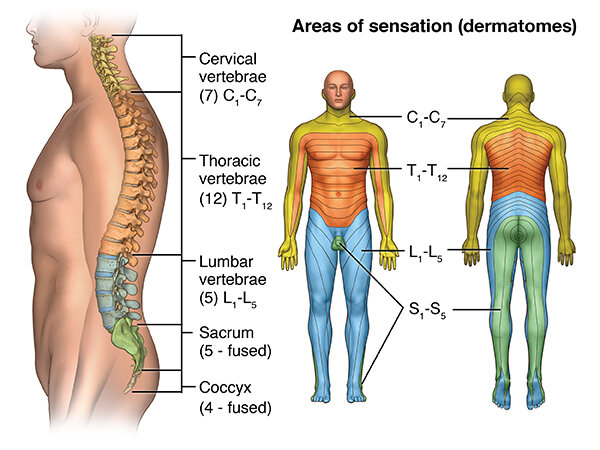 For instance, symptoms that occur along a specific dermatome may indicate a problem with a specific nerve root in the spine.
For instance, symptoms that occur along a specific dermatome may indicate a problem with a specific nerve root in the spine.
Examples of this include:
- Radiculopathies. This refers to conditions in which a nerve root in the spine is compressed or pinched. Symptoms can include pain, weakness, and tingling sensations. Pain from radiculopathies can follow one or more dermatomes. One form of a radiculopathy is sciatica.
- Shingles. Shingles is a reactivation of the varicella zoster (chickenpox) virus that lies dormant in the nerve roots of your body. Symptoms of shingles, such as pain and a rash, occur along dermatomes associated with the affected nerve root.
Dermatomes are areas of skin that are connected to a single spinal nerve. You have 31 spinal nerves and 30 dermatomes. The exact area that each dermatome covers can be different from person to person.
Spinal nerves help to relay information from other parts of your body to your central nervous system.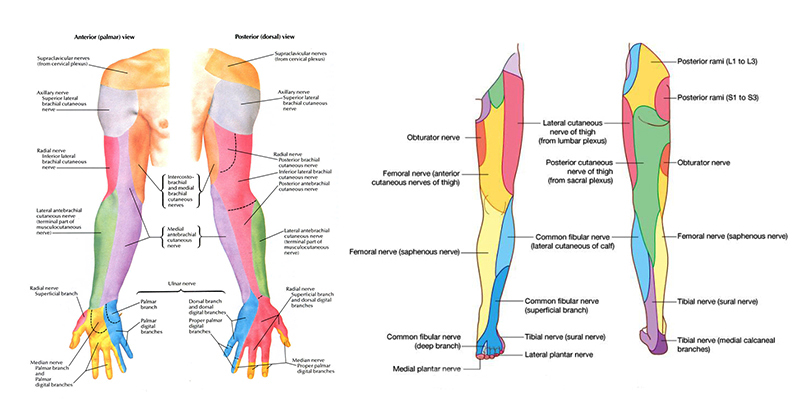 As such, each dermatome transmits sensory details from a particular area of skin back to your brain.
As such, each dermatome transmits sensory details from a particular area of skin back to your brain.
Dermatomes can be helpful in evaluating and diagnosing conditions affecting the spine or nerve roots. Experiencing symptoms along a specific dermatome can help inform doctors about which area of the spine may be affected.
Dermatomes – e-Anatomy – IMAIOS
SUBSCRIBE
SUBSCRIBE
Definition
This anatomical structure is not yet defined
I consent to the assignment of the rights associated with my participation in the project, in accordance with the Terms and Conditions of Use of the site.
I consent to the assignment of the rights associated with my participation in the project, in accordance with the Terms and Conditions of Use of the site.
Gallery
Translations
IMAIOS and certain third parties use cookies or similar technologies, in particular for audience measurement. Cookies allow us to analyze and store information such as your device characteristics and certain personal data (for example, IP addresses, navigation, usage and location data, unique identifiers). This data is processed for the following purposes: to analyze and improve the user experience and/or our content, products and services, to measure and analyze the audience, to interact with social networks, to display personalized content, to measure the performance and attractiveness of content. For more information, please see our privacy policy: privacy policy.
Cookies allow us to analyze and store information such as your device characteristics and certain personal data (for example, IP addresses, navigation, usage and location data, unique identifiers). This data is processed for the following purposes: to analyze and improve the user experience and/or our content, products and services, to measure and analyze the audience, to interact with social networks, to display personalized content, to measure the performance and attractiveness of content. For more information, please see our privacy policy: privacy policy.
You can give, withdraw or withdraw your consent to data processing at any time using our cookie settings tool. If you do not agree to the use of these technologies, this will be regarded as a refusal of the legitimate interest storage of any cookies. To consent to the use of these technologies, click the “Accept all cookies” button.
Analytical cookies
These cookies are designed to measure the audience: site traffic statistics help improve the quality of its work.
- Google Analytics
3 facts about radicular syndrome
Many students and therapists have learned that radicular pain and radiculopathy have a dermatomal distribution. But is it really so?
First of all, let’s make a distinction between radicular pain and radiculopathy. Although “radicular pain” and “radiculopathy” are used synonymously in the literature, they are not the same. Radicular pain is defined as “pain caused by ectopic discharges emanating from the spinal root or its ganglion.” It is a neuropathic, electrical pain that travels down the leg.
Radiculopathy is another, separate concept. This is a neurological condition in which conduction along the spinal nerve or its roots is blocked (Bogduk, 2009). This results in neurological symptoms such as loss of sensation, called severe hypoesthesia or anesthesia, loss of movement, called severe paresis or atrophy, or reduced reflexes, called hyporeflexia or areflexia, if they are completely absent.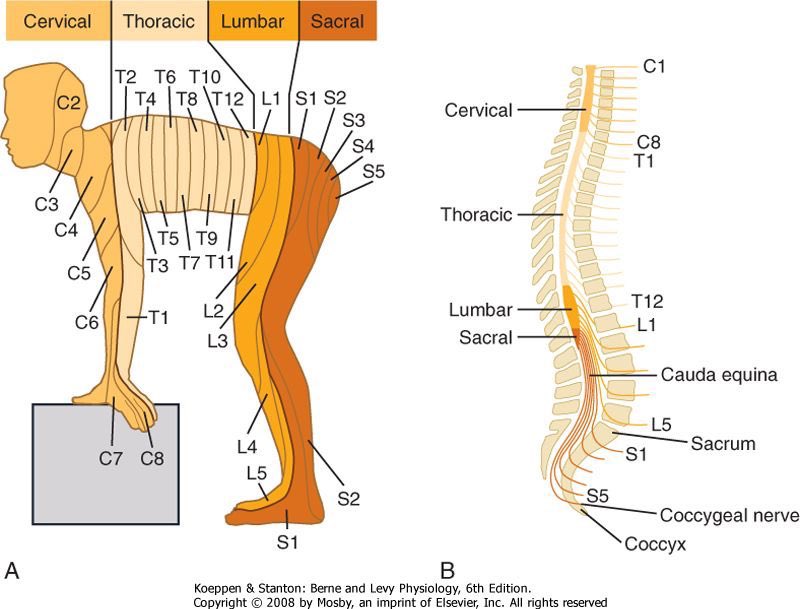 If radicular pain, radiculopathy, or both are present, we speak of radicular syndrome, which is a collective term.
If radicular pain, radiculopathy, or both are present, we speak of radicular syndrome, which is a collective term.
Is radicular pain dermatomal?
So now let’s see if radicular pain fits the dermatomal pattern. Murphy’s (2009) study observed pain patterns in patients with radicular pain and found that radicular pain in the cervical spine was accompanied by a dermatomal distribution in only 30% of cases, while it was slightly better in the lumbar spine at 36%. Now let’s look at specific dermatomes separately.
For the cervical level, only C4 seems to be more or less reliable (60%) – although we must be careful with interpretation, as there were only 2 patients with nerve root involvement at the C4 level. All other levels do not seem reliable. The same goes for the lumbar spine.
It appears that only the S1 level can be more or less reliable, as 65% of patients with S1 nerve root compression report pain in the dermatomal distribution of S1. All other levels did not correspond to the dermatomal distribution. However, it should be noted that Murphy and colleagues included patients with multilevel disease, which likely reduced the reliability slightly. In another more recent study by McAnany (2019) observed pain patterns in cervical radiculopathy. They found that only 54% matched the usual dermatome pattern as described in Netter’s anatomy book. With a non-standard distribution, dermatomal levels differed from the standard by 1.68 levels either cranially or caudally.
However, it should be noted that Murphy and colleagues included patients with multilevel disease, which likely reduced the reliability slightly. In another more recent study by McAnany (2019) observed pain patterns in cervical radiculopathy. They found that only 54% matched the usual dermatome pattern as described in Netter’s anatomy book. With a non-standard distribution, dermatomal levels differed from the standard by 1.68 levels either cranially or caudally.
How reliable are dermatomes, myotomes and reflexes?
So if radicular pain is basically defined as shooting, electrical pain throughout the distribution of the arm or leg – how reliable are our dermatomes, myotomes and reflexes? Rainville (2017) compared sensory changes and weakness in patients with C6 and C7 radiculopathy. The scientists concluded that these symptoms are of limited value in differentiating between the two levels. Al Nezari (2013) conducted a meta-analysis to see if examination of the peripheral nervous system could diagnose the level of lumbar disc herniation. They state that sensory, motor, and reflex tests have low sensitivity, moderate specificity, and limited diagnostic accuracy for determining the level of disc herniation. Thus, while a neurologic examination can help confirm the presence of radicular syndrome and assess hypofunction to establish baseline and monitor treatment progress, it cannot determine the level of nerve root compression.
They state that sensory, motor, and reflex tests have low sensitivity, moderate specificity, and limited diagnostic accuracy for determining the level of disc herniation. Thus, while a neurologic examination can help confirm the presence of radicular syndrome and assess hypofunction to establish baseline and monitor treatment progress, it cannot determine the level of nerve root compression.
Why are our dermatome maps so unreliable?
First, there is great variability in the brachial and lumbosacral plexuses. If we look at cadaveric studies of the brachial plexus, the typical anatomy of the brachial plexus was found in only 37-77% of cases. Two main variations have been described in the brachial plexus:
- We speak of “prefixation” when the C4 nerve root contributes significantly to the plexus and Th2 does not or only minimally. This variation has a prevalence between 26-48%.
- The second option is called “postfix”. This occurs if the contribution of C5 is insignificant or absent, and the innervation of Th3 is significant.
 This variation is present in 4% of the population. Prefixation or postfixation may change the observed pattern of cervical radiculopathy in the cranial or caudal direction, depending on the anatomical variant.
This variation is present in 4% of the population. Prefixation or postfixation may change the observed pattern of cervical radiculopathy in the cranial or caudal direction, depending on the anatomical variant.
The second reason is that intradural root connections in more than 50% of cadavers are found in C5 and C6 and C6 and C7. This connection between the roots of different nerve roots is called anastomosis.
Third, textbooks commonly used in medical programs contain numerous, conflicting maps of dermatomes. In addition, the fundamental foundations on which dermatomal maps have been created are imperfect in various respects. For example, the map created by Garrett and Keegan in 1948 has not yet been verified by subsequent research, but this map is mainly used in textbooks.
Lee et al. (2008) evaluated the literature and created a combined map of dermatomes based on published data from 5 studies that they considered the most experimentally reliable. Their map looks like this (which may be slightly different from what you and we learned in school).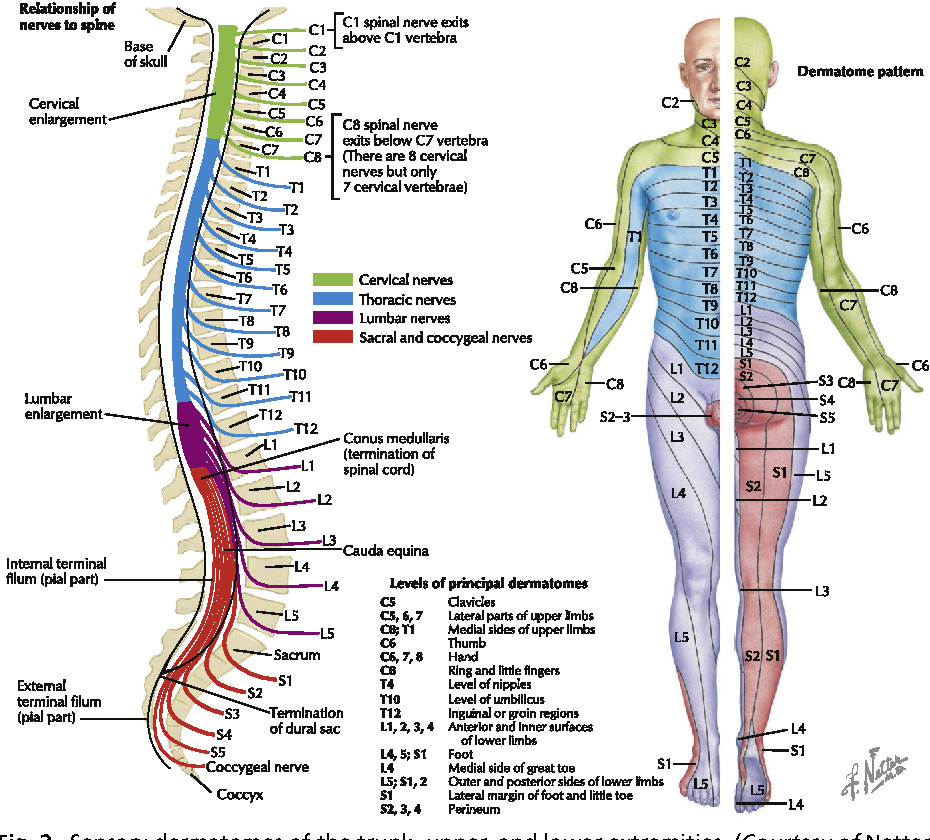


 This variation is present in 4% of the population. Prefixation or postfixation may change the observed pattern of cervical radiculopathy in the cranial or caudal direction, depending on the anatomical variant.
This variation is present in 4% of the population. Prefixation or postfixation may change the observed pattern of cervical radiculopathy in the cranial or caudal direction, depending on the anatomical variant.